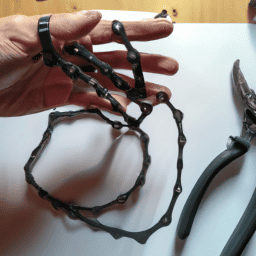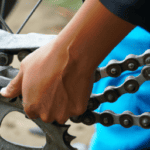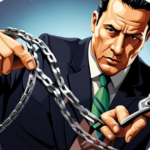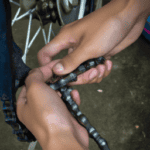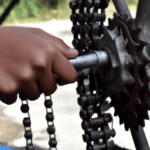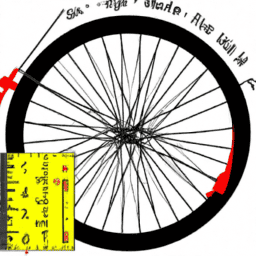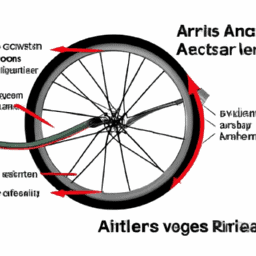Sorting out a bike chain can be an annoying and lengthy process, particularly if you’re uncertain about how to begin. Luckily, by employing the proper tools and methods, you can swiftly and effortlessly free up your chain and resume cycling.
In this article, we’ll walk you through the steps you need to take to untangle a bicycle chain, from gathering the necessary tools to reattaching the chain.
Before we get started, it’s important to note that while untangling a bicycle chain may seem daunting at first, it’s a relatively simple task that anyone can do with a little patience and practice. By following these steps, you’ll be able to untangle your chain in no time and get back to enjoying your ride.
So, grab your tools and let’s get started!
Key Takeaways
- Regular maintenance and proper lubrication can prevent chain tangles and improve bike performance.
- Use the right tools, including pliers and a chain tool, to manipulate and repair the chain.
- Straighten the chain gently to avoid causing further damage.
- Reattaching the chain is a simple process, but requires patience and precision.
Gather the Necessary Tools
First things first, you gotta grab some tools to get this chain untangled. You’ll need a few things to make sure you can get the job done right.
First, make sure you have a pair of latex gloves to keep your hands clean. It’s also a good idea to have a pair of pliers to help with any stubborn knots or tangles. Lastly, you’ll need a proper lubricant to help loosen up the chain.
Some common types of lubricants include WD-40 and chain lubricant. However, make sure you’re using the right type of lubricant for your bike and chain. Proper chain maintenance is important to keep your bike running smoothly, so make sure you’re using the right tools and lubricants.
Once you have all the necessary tools, it’s time to identify the tangled area. This is where you’ll need to pay close attention to the chain and look for any areas where it looks twisted or knotted.
You can start by manually moving the chain to see where it’s getting caught up. Once you’ve identified the area, you can start applying some lubricant to help loosen things up. With a little bit of patience and some gentle maneuvering, you’ll be able to untangle that chain in no time.
Identify the Tangled Area
One way you might notice a spot where the links are twisted together is by gently tugging on different parts of the chain and seeing where it feels stuck or resistant. This will help you identify the tangled area and focus your efforts on that specific spot.
There are several causes of chain tangles, including improper storage, lack of maintenance, and shifting gears while pedaling. To prevent chain tangles, it’s important to store your bike properly, keep the chain clean and lubricated, and avoid shifting gears while pedaling.
Once you’ve identified the tangled area, it’s time to loosen the tangles and free up the chain. This process will involve manipulating the chain with your hands and using a tool like a pair of pliers or a chain breaker. But before you begin, it’s important to remember to work slowly and carefully to avoid damaging the chain or your bike.
Loosen the Tangles
To get those pesky knots out, you’ll want to start by gently manipulating the twisted links with your fingers and a pair of pliers. This will help to loosen the tangles and make it easier to work with. Once you have identified the tangled area, you can begin to apply lubricant to the chain. This will help to reduce friction and make it easier to untangle the chain.
Using a chain tool can also be helpful in loosening the tangles. A chain tool is a specialized tool that is designed to help you remove and replace links in your chain. By using a chain tool, you can easily manipulate the links and loosen any tangles that may be present. Once you have loosened the tangles, you can move on to the next step of straightening the chain.
To straighten the chain, you’ll want to gently pull on the chain to remove any kinks or twists. This will help to ensure that the chain is properly aligned and functioning as it should. With a little bit of patience and some careful manipulation, you can easily untangle your bicycle chain and get back to riding in no time.
Straighten the Chain
To straighten the chain on your bicycle, you’ll need to use a bike stand or have someone hold the bike steady.
Once the bike is in place, carefully inspect the chain for any kinks or bends that may have formed.
Using your hands or a pair of pliers, gently straighten out any problem areas in the chain to ensure a smooth ride.
Remember to be cautious and precise when straightening the chain to avoid causing any further damage.
Use a bike stand or have someone hold the bike steady
Using a bike stand or having someone hold the bike steady will make it easier for you to access the chain. This is because having a stable base will allow you to work with your tools more efficiently and without any distractions.
With a bike stand, you can raise the bike off the ground and level it, which will give you a better view of the chain and the gears, making it easier to identify any issues that might be causing the tangles. Alternatively, someone holding the bike steady can provide the same stability while also offering an extra set of eyes to help you spot any problems.
To make the most out of using a bike stand or having someone hold the bike steady, there are a few things to keep in mind. Firstly, ensure that the bike is balanced and level before starting any work. Secondly, make sure that the person holding the bike is standing behind and slightly to one side of the bike, with their hands firmly gripping the handlebars and the seat. Thirdly, if you are working with a bike stand, ensure that the bike is securely fastened to the stand to prevent it from falling over. Finally, be sure to take your time and work carefully as you untangle the chain.
By using a bike stand or having someone hold the bike steady, you’ll be able to access the chain more easily and work more efficiently. With the stability and support that these methods provide, you’ll be able to focus on the task at hand without worrying about the bike falling over or becoming a distraction.
Once you’re finished with this step, you can move on to straightening out any kinks or bends in the chain.
Straighten out any kinks or bends in the chain
Now that you have the bike secured, it’s time to tackle any twists or curves in the chain that may be causing problems. Start by straightening out any kinks or bends in the chain. This can be done by gently pulling on the affected areas with your fingers or using a pair of pliers. Be careful not to pull too hard, as this can cause the chain to snap. Once you have straightened out the chain, it’s important to check for any damaged links that may need to be repaired or replaced.
To help prevent future tangles, it’s important to regularly maintain your bike’s chain. This includes proper chain lubrication and regular cleaning to remove dirt and debris. A well-maintained chain will not only help prevent future tangles, but it will also improve your bike’s overall performance. Once you have straightened out any kinks and properly maintained your chain, you can move on to reattaching the chain to the bike.
Reattach the Chain
First, make sure you have the necessary tools, such as pliers and a chain tool, before reattaching the chain.
When reattaching the chain, align the pins with the chain tool and push the pin through the chain link until it is flush. Repeat this process for each pin until the chain is fully connected.
It’s important to note that there are common causes of chain detachment, such as improper maintenance and wear and tear. To prevent this from happening in the future, make sure to regularly clean and lubricate the chain and check for any signs of wear.
After reattaching the chain, it’s important to adjust the tension to prevent any additional problems. Using the chain tool, push the pin through the link to disconnect the chain.
Then, adjust the tension by moving the rear wheel and reattach the chain. Once the chain is reattached, check the tension by pressing down on the chain at the midpoint between the front and rear sprockets. It should have a little bit of give, but not be sagging.
Overall, reattaching the chain is a relatively simple process that can be done with the right tools and a little bit of patience.
Frequently Asked Questions
How often should I clean and lubricate my bicycle chain?
To ensure optimal cycling maintenance and chain durability, clean and lubricate your bicycle chain every 100-200 miles or after riding in wet or dirty conditions. Use a degreaser and a lubricant specifically designed for bicycle chains.
Can I use any type of lubricant on my bicycle chain?
You can use WD-40 on your bicycle chain, but it’s not ideal. It’s a degreaser, so it’ll strip away the lubricant and attract dirt. Instead, use a bike-specific lubricant, or try wax or ceramic coatings for longer-lasting protection.
What is the best way to prevent my bicycle chain from getting tangled?
Your bicycle chain maintenance routine must include chain tension adjustment. Proper tension prevents tangles and excessive wear. Think of the chain as a musical instrument: tune it regularly to avoid a discordant ride.
Should I replace my bicycle chain if it is severely tangled?
If your bicycle chain is severely tangled, replacing it may be necessary. The cost of chain replacement varies depending on the type of chain. Attempting DIY chain untangling may cause further damage and is not recommended.
Can I still ride my bicycle if my chain is tangled?
Riding with a tangled bicycle chain can be dangerous, causing injury or damage to the bike. Tips for preventing tangles include proper maintenance and storage. If your chain is tangled, untangle it or replace it before riding.
Conclusion
Congratulations! You’ve successfully untangled your bicycle chain. Like a skilled surgeon, you delicately removed each knot and straightened out the chain to restore it to its former glory.
As you reattach the chain, you feel a sense of satisfaction and accomplishment.
Remember, just like a tangled chain, life can sometimes throw us for a loop. But with patience, determination, and the right tools, we can untangle even the toughest knots.
So the next time you find yourself in a tangled mess, remember that you have the power to unravel it and come out on top. Keep pedaling forward, and don’t let anything hold you back.
